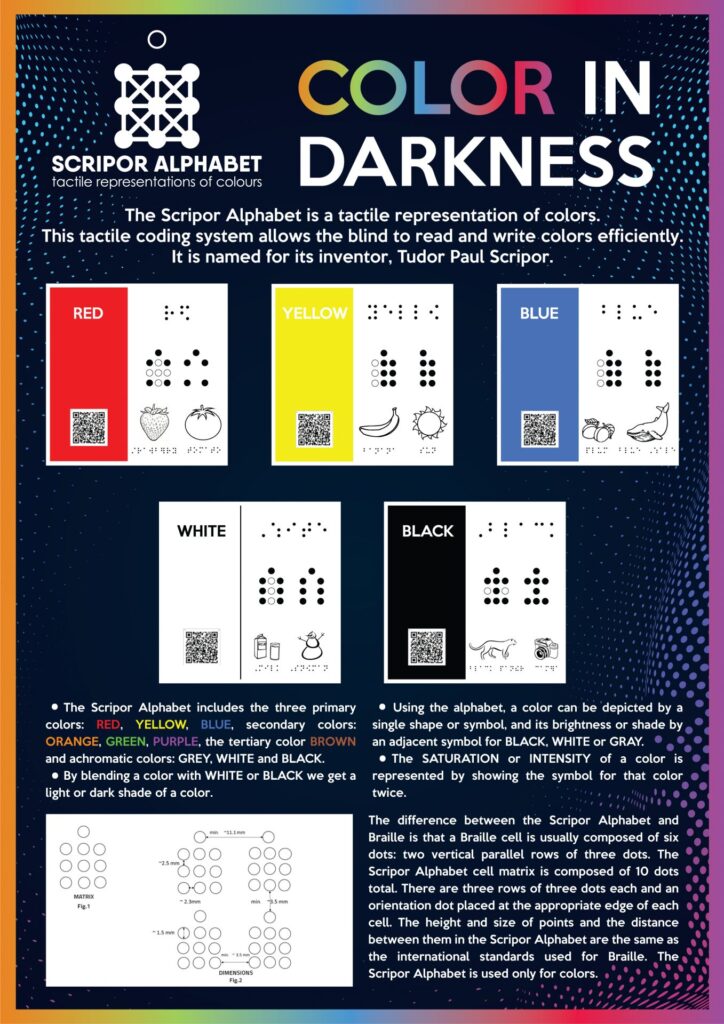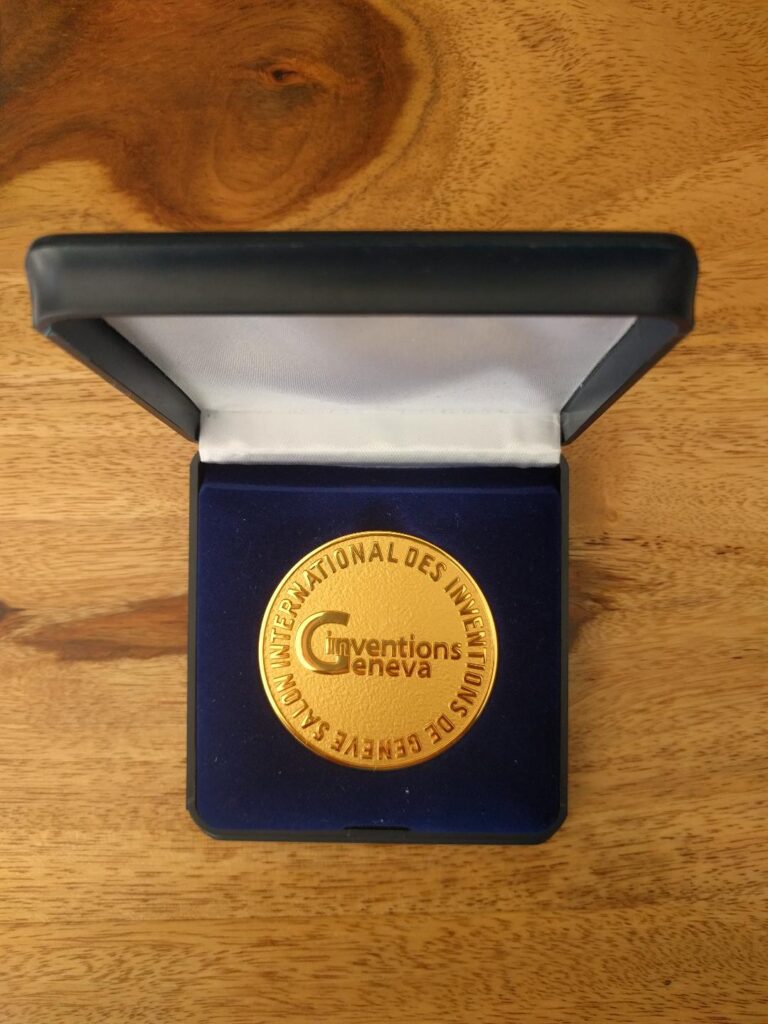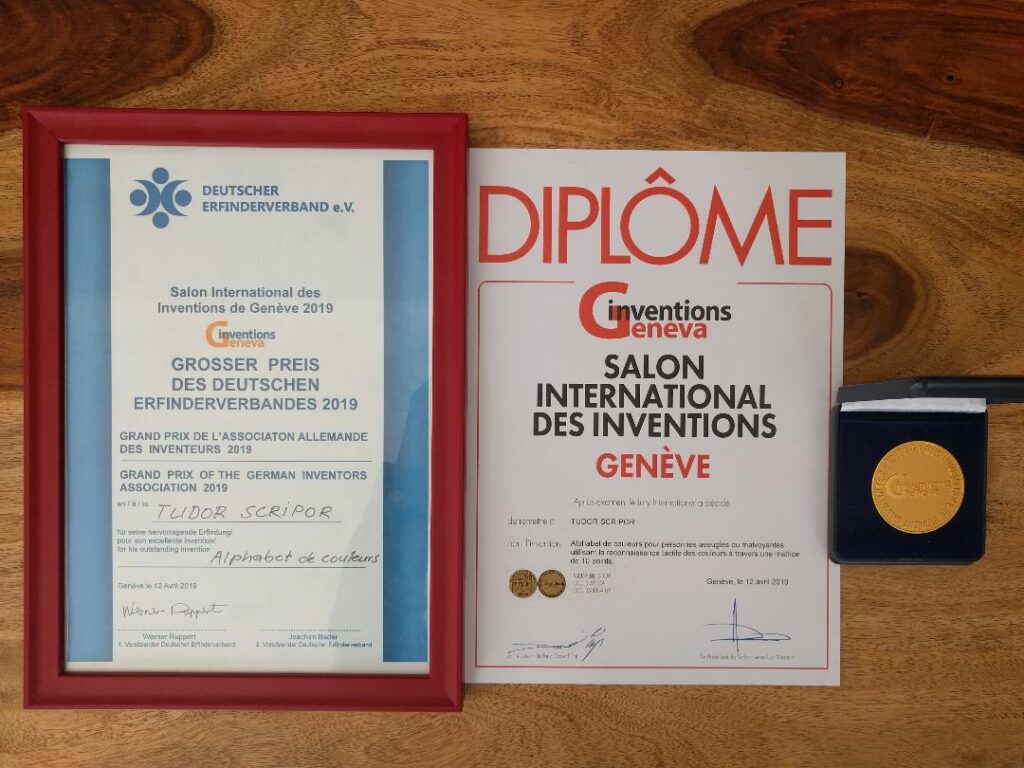The passion for painting of a Romanian has led to the creation of an alphabet of colors for the visually impaired. Impressed by the story of a young woman who lost her sight, Tudor Scripor decided to bring back the joy of color recognition to the visually impaired. Thus, he created “the Scripor Alphabet,” known as the tactile representation of colors, which is a tactile coding system that allows the blind to read and write colors efficiently.
The code is composed of a system of geometric shapes associated with the three primary colors: red, yellow, and blue. By combining them, three secondary colors can be formed, such as orange, green, brown, and purple, and they are supplemented by the non-colors gray, black, and white.
Although at first glance, this alphabet may seem to have limited uses, the researcher has shown us that the system used to represent colors covers a wide variety of fields. The visually impaired can use the knowledge gained from learning this alphabet in medicine, for recovery and treatment, in education, as it helps in better and faster learning of the basic alphabet, Braille, in the fashion industry, in visual arts, architecture, tourism, fashion, public transportation, and even in assistive technology (software, hardware, applications, devices).
In an exclusive interview with Editiadedimineata.ro, Tudor Scripor talked to us about the utility of this language and the unique experience of participating in the International Fair in Geneva, where he was nominated to receive the gold medal. Moreover, he shared the starting point of this daring project and the chances of this alphabet being used by the visually impaired worldwide.
“The idea was born out of necessity. At one of my painting workshops, a visually impaired person attended, and it was very difficult for me to communicate with him in the language of colors. Until now, everything represented for the visually impaired was in a 3D form or bas-relief. All famous paintings are represented in this way, but this form of art, because bas-relief is a form of art, does not convey the chromatic information given by color, and color represents a form of emotion. I couldn’t communicate this form of emotion to the visually impaired person, so I set out to create an alphabet, a code for color recognition and interpretation. This happened seven years ago, in 2012,” Tudor Scripor recounted.

Two alphabets in one
“It was very difficult to start because, first of all, I faced many difficulties, such as people’s lack of confidence, as I had no moral support or backing because everyone told me that <> Well, starting from a study that says that visually impaired people dream in colors, I had a starting point. They dream in colors and associate the emotions they experience during the day with colors. Well, that was the starting point. I associated geometric shapes: circle, square, and rectangle with the three primary colors, red, yellow, and blue. Red represents the sensation of warmth and expansion, and I associated it with the geometric shape of a circle, which is often associated with infinity, while blue represents the sensation of coldness because a square has four corners and is angular, in a non-academic language. Well, these shapes and primary colors, red, yellow, blue, circle, square, and rectangle, combined result in other secondary shapes and other secondary geometric shapes. For example, red and yellow will result in the color orange when mixed, and if the shapes overlap, the rectangle with the circle will result in an oval, which is a combination of rectangle and circle. All the colors and resulting geometric shapes were introduced into a matrix similar to Braille, but consisting of nine dots plus an orientation dot. I maintained the distance and dimensions of the Braille alphabet dots, which are already internationally standardized, and a tactile language of colors for the visually impaired emerged. For sighted people, on the other hand, we are talking about people who have had brain surgery, who can see but have forgotten colors, we use the language of geometric shapes, and we have seen that it yields very good results. We are still in the research stage because we also want to see how it can help children with autism. In practice, we have two alphabets in one,” he added.
The researcher also emphasized that this alphabet is quick and easy to learn. Furthermore, based on several studies in this regard, it seems that preschoolers who are introduced to this alphabet before learning Braille are much more receptive and learn to write, read, and recognize letters much faster. The characters of the Scripor alphabet are so easy to assimilate because they have elements from the common knowledge area as well as from the Braille alphabet area.
Moreover, compared to the Braille alphabet, which can take up to two years to learn, the alphabet of colors has a relatively short understanding time. Studies conducted by researchers have shown that a visually impaired person can learn and recognize colors in various contexts within a few days.
“The Scripor alphabet is Braille-related, but it can precede Braille. That means a person who already knows the Braille alphabet can quickly learn the alphabet of colors. However, younger children, such as preschoolers or kindergartners, can be prepared to learn Braille with the help of my alphabet, which is very beneficial. Children learn a lot through play, so we will try to create many toys that contain these color symbols because it greatly aids their education, and they will learn the alphabet through play,” explained Tudor Scripor
A Universal Language
“The main characteristic of the color alphabet is its universality because we represented colors using a single symbol. Thus, the symbol for red is universal in Japan, China, India, as well as in Romania. There is no need to write ‘red,’ ‘rouge,’ or other words using Braille letters; only a symbol for the color is required,” added Tudor Scripor.
The Romanian’s initiative is not unique. Over time, there have been enough researchers or even visually impaired individuals who have attempted such an approach of assigning specific shapes to colors for easier distinction. However, no one has succeeded in discovering a universally applicable method so far. Each person has only made personal interpretations of colors based on their own experiences and emotions.
“There have been many attempts to represent colors, but they have been made by people who adopted a particular language. Unfortunately, these attempts have failed precisely because they lack logic. For example, one visually impaired person represented the color green as a wavy line and red as dots. Well, it means a lot to him and is a sign of recognition, but for others, it doesn’t make any logical sense and doesn’t represent anything. That’s why these forms of language could not be generalized or spread. However, my language has logic because it relates to geometric shapes in the mind. We can even talk about the blind individuals who have never seen because those who lost their sight later in life find it much easier to remember colors and shapes. Furthermore, my alphabet is transposed into a Braille-like matrix,” said Tudor Scripor.
It is already known that the great inventions of the world were initially disputed by society. The undeniable usefulness of this code was not recognized by Romanian investors, who treated the Romanian’s bold project with skepticism. Therefore, the researcher laid the foundation of the project using his own financial resources. However, this did not lead to the discontinuation of research but rather motivated him to continue the study, even if luck was not on his side.
“Now we are in discussions with potential partners who want to ensure that our endeavor is implemented globally and even standardized. Think about clothing. For example, we had a young visually impaired woman who lost her sight in her adolescence, and she was very sad because she didn’t know the colors of her clothes. Well, I told her that through a symbol sewn on the label, she can choose her clothes without needing assistance. Visually impaired individuals seek the practicality of this alphabet directly in their lives. We are also having open discussions for the European standardization of this code,” he further mentioned.

Even though Tudor Scripor’s patent has been recognized internationally, it seems that he has not managed to convince the Romanian state or investors to finance the promotion of his invention on an international scale this time either. So Tudor, along with his team, attended the International Exhibition of Inventions in Geneva with their own funds.
“Even our participation in Geneva was self-funded. We did not receive any assistance or subsidies from the state in any form, but we are open to partnerships and we truly desire to have strong partners, both financially and educationally, who can support us in implementing this color code,” Tudor Scripor further explained.
The Scripor Alphabet, nominated for the gold medal.

“At the Geneva International Exhibition of Inventions, we were required to have a patent, which we obtained back in January. Once we had the patent, we registered for the exhibition. The invention was accepted, and together with my team, we went there without any expectations, only to present this project to the whole world. When we arrived there and presented the invention to the jury, the discussions were very positive, and we were nominated for the special prize offered by the Association of Inventors from Germany, as well as for the gold medal,” he added.
All in all, this project has every chance of becoming internationally recognized. Both the researcher and the jury at Geneva have hopes that the Scripor Alphabet will one day be used by visually impaired individuals worldwide. However, to make this possible, a lot of work and substantial financial resources are needed. When asked what he would do if he had unlimited financial resources, he vehemently responded that he would continue to invest in this project.

“I hope that this project will help visually impaired people worldwide, especially those in poor countries who would benefit greatly in literacy with the help of this alphabet. However, let’s not forget that this alphabet does not serve the purpose of recognizing or recalling colors; it has a role in creativity. In a few years, or even sooner, we hope to enable visually impaired individuals to express themselves through this language. These individuals can create in their own right, and it is fascinating to see what will result from their imagination. It is truly interesting to understand how a visually impaired person envisions a painting. Because, in my opinion, when all visually impaired individuals are included or aided to be closer to our world, everyone stands to gain,” concluded Tudor Scripor.

